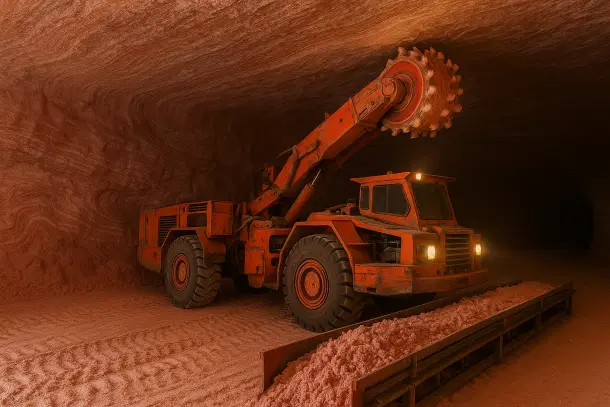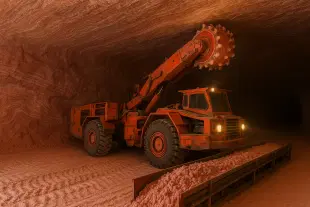Economy
Atmanirbharta Begins In The Desert: Why Bikaner Is India’s Next Big Thing
Deepesh Gulgulia
Jun 17, 2025, 09:55 AM | Updated 09:55 AM IST
Save & read from anywhere!
Bookmark stories for easy access on any device or the Swarajya app.


India’s ambitious dream of Atmanirbhar Bharat, self-reliant and globally competitive, cannot be fulfilled without tapping into its untapped heartlands. One such land of opportunity is Bikaner in Rajasthan, a district often associated with history, heritage, and snacks, but rarely with industrial potential. Yet, lying quietly under its desert soil is a treasure trove of minerals, clay, and enterprise waiting to be harnessed.
The region holds the lion’s share of India’s potash reserves, nearly 95 per cent with major deposits concentrated in Bikaner and nearby Hanumangarh. With India importing over Rs 8,000 crore worth of potash in 2024-25 alone, tapping into these reserves can be a game-changer.
But that’s not all. Villages in Bikaner, Chandi, Gurha, Mudh, and Kolayat hold clay deposits identical to Ukrainian clay, the core raw material used by ceramic manufacturers in Morbi, Gujarat. India imports nearly $1.4 billion worth of this clay annually. If developed, Bikaner can not only support Morbi but also evolve into a ceramic hub of its own.
Add to this a thriving local food processing industry with over 1,000 units, and Bikaner’s industrial roadmap becomes clear. The only missing link? Infrastructure and urgency. This piece outlines how Bikaner can unlock its potential and what must be done to make it happen.
Potash
India is one of the largest consumers of potash, a critical agricultural input used in fertilisers. Yet, we remain entirely import-dependent, spending over Rs 8,000 crore in 2024–25 to procure it from countries like Russia, Canada, Israel, and Turkmenistan. This not only burdens our exchequer but also exposes us to global supply shocks.
Enter Rajasthan, home to over 95 per cent of India’s total potash reserves, with the most significant deposits located in Bikaner and Hanumangarh districts. What makes this even more promising is that these potash-rich areas are clustered within a compact zone, with several Hanumangarh villages located just a few kilometres from Bikaner’s boundary.
Recognising this, the Ministry of Mines had initially identified two potential mining sites, one in Bikaner, the other in Hanumangarh. However, the tender conditions were rigid. Companies were required to mine all minerals present at the site, not just potash, which made the project financially unviable. Industry players like Vedanta expressed interest but backed off due to the massive estimated cost potentially running into over Rs 1 lakh crore.
After industry consultations, the Centre modified its approach. In September 2024, the ministry allowed selective mining of potash. The Hanumangarh site was retendered under the new guidelines, and Vedanta successfully won the bid. Mining operations are now set to commence in the coming months.
However, the more resource-rich site in Bikaner remains untapped. Despite the potential, as of 9 June 2025, no fresh tender has been floated. This delay is holding back what could be one of India’s most strategic self-reliance projects. If developed fully, potash mining in Bikaner can drastically cut imports, stabilise prices for farmers, and even open up avenues for exports in the future. The resource is ready. The policy is halfway there. What’s needed now is urgency.
Clay
India’s ceramic industry thrives on exports, with Morbi, Gujarat, as its beating heart. Yet the industry bears a costly dependency: Ukrainian clay, a vital raw material in manufacturing vitrified tiles and sanitaryware. Every year, Indian ceramic producers import nearly $1.4 billion worth of this clay, leaving the industry vulnerable to geopolitical disruptions and forex volatility.
A study published in the American Institute of Physics by researchers from Dungar College and the College of Engineering and Technology, Bikaner, concluded that blended clay from villages like Chandi, Gurha, Mudh and Kolayat in the Bikaner region is chemically and mechanically comparable to Ukrainian clay. The blend, named B2, not only matched Ukrainian clay in composition but actually outperformed it in fired strength and whiteness, making it ideal for ceramic whitewares like tiles and sanitary products.
Industrial giants such as Vermora, Nexion, and RAK Ceramics have shown interest in this local substitute. For them, switching to indigenous clay would cut costs, improve supply reliability, and enhance India's self-reliance in ceramic production.
However, the major stumbling block remains infrastructure, especially the lack of a dry port in or near Bikaner. While the Rajasthan government announced a dry port in Bikaner in the 2022–23 state budget, actual development has been stagnant. Only recently has land been identified, but construction is yet to begin. Without proper cargo handling facilities, large-scale material transport remains a logistical and financial challenge.
If harnessed with intent, Bikaner’s clay reserves can become a backbone for India’s ceramic sector, reducing dependency on unstable foreign sources and potentially establishing Bikaner as a complementary hub to Morbi. The science is in. The soil is ready. Now, the system needs to follow.
Food Processing Industry And Bikaneri Snacks
Even before minerals, Bikaner thrived on flavour. Its food processing industry, built on legacy and taste, has over 1,000 registered units producing snacks, sweets, pickles, and millet-based products. The city’s claim to fame, Bikaneri Bhujia, holds a GI tag and is sold across the globe.
Brands like Bikaji, Haldiram’s, and Bhikharam Chandmal have shown how Bikaneri flavour can be scaled nationally. Yet, export logistics remain poor. Despite an operational civil airport, there's no cold chain infrastructure, no integrated food park, and no direct export channels.
With millet gaining international spotlight and traditional Indian snacks in high demand, Bikaner’s food industry has a ready market. What it needs now is infrastructure to scale.
The Bottom Line: If Bikaner is a treasure chest of untapped industrial potential, infrastructure is the key still stuck in the lock.
Across sectors — potash mining, ceramic manufacturing and food processing — a common challenge recurs, that is, lack of connectivity and logistical readiness. Despite resources, interest from industry giants, and even policy announcements, execution remains the bottleneck.
Bikaner is landlocked, and the nearest major seaport is Mundra in Gujarat, nearly 900 km away. Without a dry port to connect to this or any other port via rail freight, export-oriented industries suffer from higher logistics costs and longer lead times. This affects food exports, mineral transport, and any vision of a global Bikaner brand.
Bikaner has a functional civil airport but with limited cargo services. If upgraded with warehousing and cold storage infrastructure, it can boost perishable exports, especially for the food sector. But without a policy push or private participation, it remains underused.
For Bikaner to transform into an industrial powerhouse, the infrastructure gap must be bridged quickly and strategically. Without it, natural resources and industrial ambition risk turning into just another regional promise.
Deepesh Gulgulia is a Law student. He tweets at x.com/@deepeshgulgulia.





